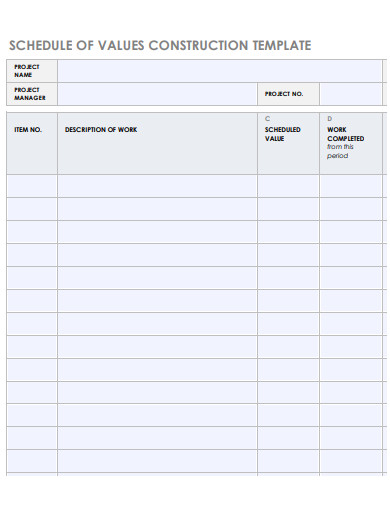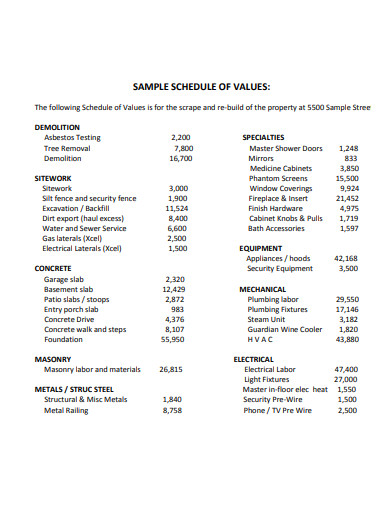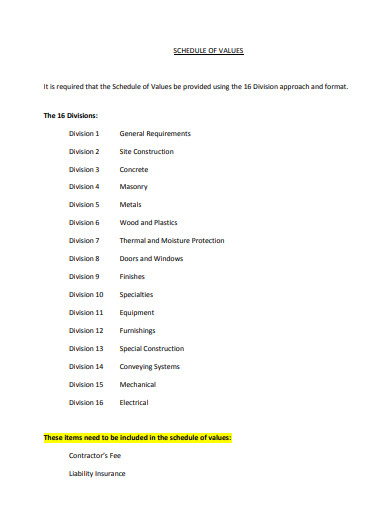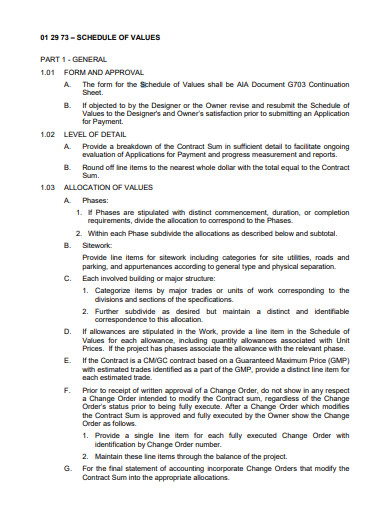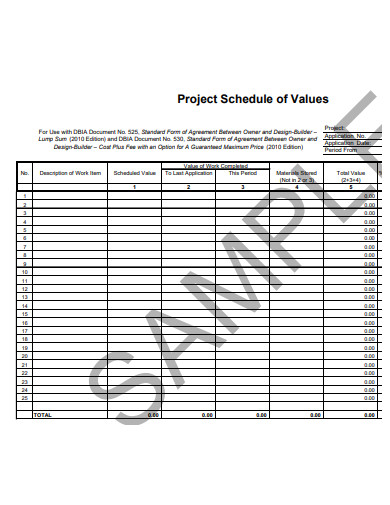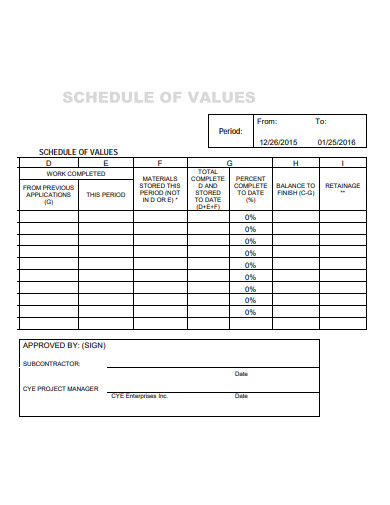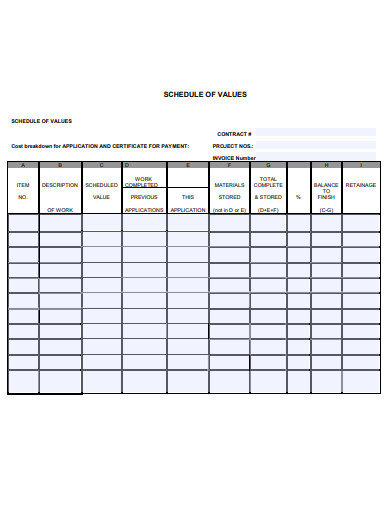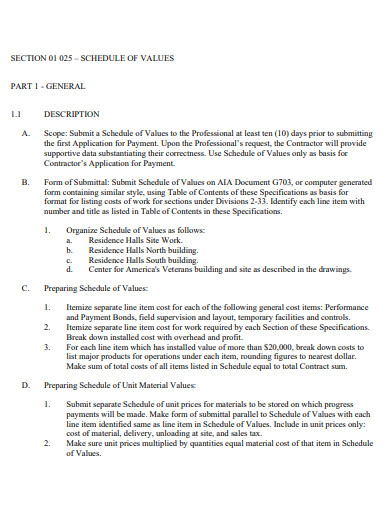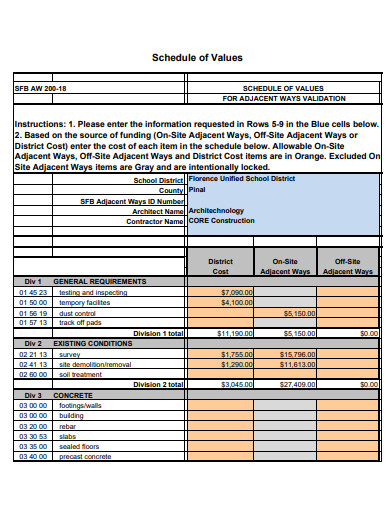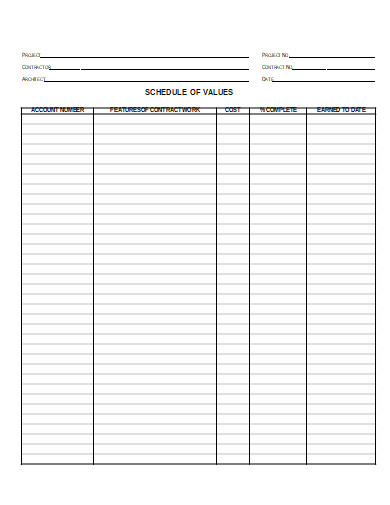The Schedule of Values (SOV) is the most critical measure in a construction project for monitoring your performance as a contractor, getting paid on schedule, and (possibly most significantly) controlling your cash flow – especially on bigger commercial construction projects. Even if you haven’t produced a Schedule of Values yet, as your firm grows and you take on larger commercial tasks, it’s important to understand so you can succeed in the future. If the project is mishandled or executed incorrectly, it may cause cash flow problems throughout the project’s life cycle and beyond.
10+ Schedule of Values Samples
A Schedule of Values, or SOV, is a breakdown of all work items on a project, as well as the worth or cost of each item. From start to finish, this detailed task list covers the overall construction project and the entire contract amount. “The schedule of values shall apportion the whole contract sum among the various segments of the work,” according to the American Institute of Architects’ (AIA) standardized contract forms. The value schedule depicts the entire project on paper, progressively. This enables the organization or project owner to know how much of each item has been finished on time. The schedule of values is normally submitted along with a request for payment and any other supporting documentation.
1. Schedule of Values
2. Schedule of Values Construction
3. Sample Schedule of Values
4. Simple Schedule of Values
5. Basic Schedule of Values
6. Project Schedule of Values
7. Subcontractor Schedule of Values
8. Basic Schedule of Values
9. Formal Schedule of Values
10. Professional Schedule of Values
11. Printable Schedule of Values
On big construction projects, a Schedule of Values is frequently used to track progress and organize contractor online payment system. It offers much-needed accountability and assure that a tasks are accomplished, contractors are paid properly, and no items get lost in the shuffle.
The SOV enables the project owner or architect to keep track of the proportion of the project that has been finished while also determining how much they will need to pay workers at each stage. Contractors utilize the record to plan and track their cash flow, issue bills on time, and present it with each milestone payment application as confirmation of their work.
How carefully you put together the Schedule of Values determines the frequency of your progress payments – a subcontractor’s cash flow during a transaction. And, as any contractor understands, cash flow is crucial when you’re working with tight margins and even tighter timeframes.
When you present a payment receipt, the owner or architect will assess the job and either dispute or issue payment based on the Schedule of Values.
Billing inconsistencies or disagreements should be minor, if they arise at all, if the SOV was settled upon as part of the contract. This allows you to get payments on time, ensuring that you have enough cash flow to execute your project on time. It’s critical that the exact amounts and dates are clearly specified and consented upon in the initial contract in order to maintain cash flow consistent. Change orders will very definitely be issued throughout the project, and the SOV will be amended to incorporate these new additions.
FAQs
Who needs to use a schedule of values normally used?
Prime or general contractors, as well as second-tier subcontractors (those employed by the GC), use a schedule of values to support their payment application. The schedule of values is used by project owners and architects to verify the work done and release payment.
Does schedule of values change according to the project location?
The location of the project has no effect on the value timetable. It is not governed by statute in the same way that mechanics lien laws or even some contract provisions are. The SOV form utilized may vary slightly based on the needs of the owner, architect, or general contractor. These discrepancies, however, are unrelated to the project’s location. Variations are largely dependent on the contracts used and the level of information requested. This isn’t to argue that geography can’t have an indirect effect. It’s possible that architects in one region may define a level of detail in a schedule of values that isn’t necessarily the same in other locations.
A schedule of values is a management system for processing pay applications, as well as a useful tool for reviewing project progress against the plan. Because the SOV is used to calculate cash flow, the timing of payments is determined by how well the contractor put the SOV altogether.
Related Posts
FREE 10+ Gym Schedule Samples in PDF | MS Word | Apple Pages | Google Docs | Keynote |
FREE 10+ Daily Hourly Schedule Samples in PDF
FREE 10+ Weekly Schedule Template with Hours Samples in PDF
FREE 10+ 7 Day Weekly Schedule Samples in PDF
FREE 10+ Working Schedule Template Samples in PDF
FREE 6+ Preschool Schedule Template Samples in PDF
FREE 10+ Daily School Schedule Samples in PDF | MS Word | Google Docs | Google Sheets | Excel
FREE 10+ Day Schedule Samples in PDF
FREE 10+ Daily Work Schedule Samples in PDF
FREE 10+ 24 Hours Schedule Samples in PDF | Word | Google Docs | Google Sheets | Excel | Apple Numbers | Apple Pages
FREE 10+ Baseball Schedule Samples in PDF
FREE 10+ Availability Schedule Samples in PDF
FREE 10+ Weekly Cleaning Schedule Samples in PDF
FREE 8+ Employee Scheduler Template Samples in PDF
FREE 10+ Weekly Work Schedule Samples in PDF


